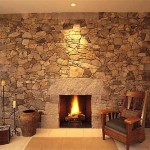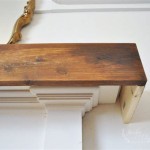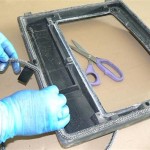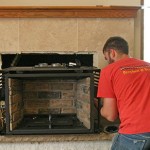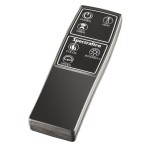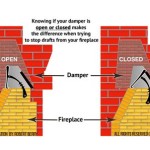Fireplace Mantel on Brick Wall: A Comprehensive Guide
The installation of a fireplace mantel on a brick wall is a common home improvement project that can significantly enhance the aesthetic appeal of a living space. A mantel not only serves as a decorative focal point but also provides a functional shelf for displaying artwork, photographs, and other cherished items. Successfully mounting a mantel on brick requires careful planning, precise execution, and the use of appropriate materials and techniques. This article delves into the various aspects of this project, covering key considerations, installation methods, and design ideas.
Understanding the Challenges of Mounting on Brick
Brick, while structurally sound, presents unique challenges compared to mounting on drywall or wood. The primary obstacle is the inherent hardness and potential brittleness of the brick itself and the mortar joints. Drilling into brick requires specialized tools and techniques to avoid cracking or crumbling. Furthermore, the irregular surface of brick can make it difficult to achieve a perfectly flush and secure mount. The condition of the brick and mortar is also a critical factor. Older brick walls may have weakened mortar joints, necessitating repair before any mounting attempts.
Choosing the right type of fasteners is paramount. Standard wall anchors designed for drywall are insufficient for brick. Instead, masonry anchors, specifically designed for use in concrete, brick, and stone, are required. The load-bearing capacity of these anchors must be carefully considered, taking into account the weight of the mantel itself and any items that will be placed upon it. Overlooking this aspect can lead to a compromised installation and potential safety hazards.
Accurate measurement and marking are crucial. Unlike working with wood where minor adjustments can be easily made, errors in drilling into brick are more difficult to rectify. Precise measurements are necessary to ensure that the mantel is level and properly positioned. Using a level and a stud finder to identify any hidden utilities behind the brick wall is highly recommended before beginning any drilling.
Methods for Mounting a Mantel on Brick
Several methods exist for mounting a mantel on a brick wall, each with its own advantages and disadvantages. The choice of method depends on factors such as the weight and size of the mantel, the condition of the brick, and the desired aesthetic.
1. Using Masonry Screws Directly into the Brick: This method is suitable for lighter mantels and requires drilling pilot holes into the brick using a hammer drill with a masonry bit. The diameter of the pilot hole must be slightly smaller than the diameter of the masonry screw. After drilling the pilot holes, masonry screws are inserted directly into the brick. These screws are typically coated with a corrosion-resistant material to prevent rusting. The head of the screw can be countersunk to create a flush finish, or washers can be used to distribute the load more evenly.
2. Utilizing Mortar Joint Mounting: This technique involves anchoring the mantel into the mortar joints rather than the bricks themselves. Mortar joints are often weaker than the bricks, but using them can minimize the risk of cracking the bricks. Expansion anchors, specifically designed for use in masonry, are commonly used in this method. The process involves drilling holes into the mortar joints, inserting the expansion anchors, and then tightening them to create a firm grip. This method is particularly effective for mantels that have a wide mounting surface, allowing for multiple anchor points along the mortar joints.
3. Employing a French Cleat System: A French cleat is a mounting system consisting of two interlocking pieces of wood or metal. One piece is attached to the brick wall, and the other is attached to the back of the mantel. The two pieces interlock, providing a strong and secure connection. When mounting the cleat to the brick, masonry anchors are required. Because the weight is distributed along the length of the cleat, this method is particularly suitable for heavier mantels. The French cleat system also allows for easy removal of the mantel for cleaning or redecoration.
4. Using Construction Adhesive in Conjunction with Anchors: For added security, construction adhesive can be used in conjunction with masonry anchors. This method involves applying a bead of construction adhesive to the back of the mantel before mounting it to the brick wall. The adhesive provides an additional layer of bonding, helping to distribute the weight and prevent the mantel from shifting. It is crucial to select a construction adhesive that is specifically formulated for use with masonry materials. Ensure the surface is clean and free from dust or debris prior to applying the adhesive.
Regardless of the chosen method, it is essential to pre-drill the mantel for the mounting hardware. This step helps to ensure that the screws or bolts align properly with the anchors in the brick wall. Using a drill press can help to create accurate and consistent pilot holes in the mantel.
Design Considerations for Fireplace Mantels on Brick Walls
The design of a fireplace mantel should complement the style of the room and enhance the overall aesthetic. Various materials and finishes can be used to create a mantel that reflects the homeowner's personal taste. Common materials include wood, stone, and metal, each offering its own unique characteristics.
1. Wood Mantels: Wood mantels are a classic choice, offering warmth and versatility. They can be painted, stained, or left natural to showcase the wood grain. Different types of wood, such as oak, maple, and pine, offer varying degrees of durability and visual appeal. Reclaimed wood mantels are also a popular option, adding a rustic and unique touch to the fireplace. When selecting a wood mantel, consider the existing woodwork in the room to ensure a cohesive design.
2. Stone Mantels: Stone mantels exude a sense of elegance and permanence. They can be crafted from a variety of materials, including granite, marble, and limestone. Stone mantels are typically heavier than wood mantels, requiring more robust mounting hardware and potentially structural reinforcement. The natural variations in color and texture of stone add character and depth to the fireplace.
3. Metal Mantels: Metal mantels offer a sleek and modern aesthetic. They can be made from materials such as steel, iron, and aluminum. Metal mantels are often powder-coated to provide a durable and corrosion-resistant finish. They can be customized with various designs and embellishments, ranging from simple lines to intricate patterns.
The size and proportions of the mantel should be carefully considered in relation to the size of the fireplace and the overall dimensions of the room. A mantel that is too large can overwhelm the space, while a mantel that is too small may appear insignificant. A general rule of thumb is to choose a mantel that is slightly wider than the fireplace opening. The height of the mantel should also be proportionate to the height of the ceiling and the size of the room.
The style of the mantel should align with the architectural style of the home. For example, a traditional home may benefit from a mantel with ornate carvings and decorative moldings, while a modern home may be better suited for a minimalist mantel with clean lines and a simple finish. Consider the overall color scheme of the room when selecting the finish for the mantel. A contrasting color can create a dramatic focal point, while a complementary color can create a more subtle and harmonious look.
The mantel shelf provides an opportunity to display decorative items that reflect the homeowner's personal style. Paintings, sculptures, photographs, and vases can all be used to create an eye-catching display. Consider the scale and proportions of the items being displayed in relation to the size of the mantel shelf. Avoid cluttering the mantel with too many items, as this can detract from its overall aesthetic appeal. Utilize varying heights and textures to create visual interest. Incorporating seasonal decorations can also enhance the mantel's appeal throughout the year.
Lighting can be used to accentuate the mantel and highlight the decorative items displayed upon it. Recessed lighting, sconces, or even strategically placed candles can create a warm and inviting ambiance. Consider installing a dimmer switch to control the intensity of the lighting and create different moods. The placement of the lighting should be carefully considered to avoid glare or shadows. Uplighting can be used to highlight the texture of the brick wall, while downward lighting can be used to illuminate the mantel shelf.
Furthermore, the integration of the mantel with the surrounding architectural elements is critical. The mantel should seamlessly blend with the overall design of the room, enhancing its aesthetic appeal without appearing out of place. Consider the relationship between the mantel and other features, such as the fireplace surround, the flooring, and the wall color. A well-designed mantel can transform a simple fireplace into a stunning focal point that adds value and character to the home.

How To Install A Mantel On Brick Fireplace 1905 Farmhouse

How To Install A Floating Mantle The Easy Way In Just One Afternoon

Spring Inspired Mantle Fireplace Mantel Decor Brick Makeover

How To Install A Mantel On Brick Fireplace 1905 Farmhouse

Build A Mantel Over Brick Fireplace

The Making Of A Slip Covered Mantel Made By Carli

Rough Hewn Wood Diy Fireplace Mantel Addicted 2 Decorating

Rough Hewn Wood Diy Fireplace Mantel White Brick

30 Timeless Wood Mantels For Brick Fireplace Designs

How To Make A Diy Fireplace Mantel The Idea Room
Related Posts

